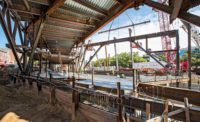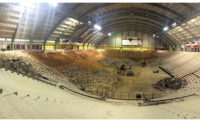Team members used BIM extensively throughout the design process, allowing them to model architectural elements, conduct energy-related modeling and maintain a regularly updated cost model. One federated model was shared by the team with a BIM facilitator to help ensure integration.
Riz says the integrated process of developing the design and iterative cost models was allowed to remain relative fluid in the early stages. The team quickly realized that it had opportunities to expand the job well beyond the original scope, he says.
The project was initially envisioned as a retrofitted building with an addition. But the team changed the plan to a 35,000-sq-ft retrofit of an existing building and a new 25,000-sq-ft building, with extensive site development to link the two.
At first the two-building concept looked like it would run nearly $3 million above budget. But Riz says the team was confident it could hit its target number. "It was a long process of chipping away at [the cost] during the design period," he says.
"We weren't pressured to get it back to budget in two weeks; it was an evolutionary approach," he adds. "As more information was put into the model, we were given accurate pricing. Then we could go back to the project values to decide what we should keep and what we should discard or modify."
Ultimately, the Dept. of General Services requested that the project come in at around 90% of budget in the bidding documents, DiBartolo says. This would allow the team a cushion, in case issues arose during construction.
Fortunately, that approach paid off. DiBartolo says that during renovation of the existing building, which was built in 1942, the team discovered significant unforeseen issues in the exterior shell. The team was able to use its contingency allowance to cover the cost.
Traditional Hurdles
Although team members consider the integrated design approach to be a success, they still faced the traditional challenges of a design-bid-build approach. "We hoped to see a cultural change in the prime low-bid scenario, but when the heat got turned up, people went back to normal behaviors and retreating to their silos instead of coming together," DiBartolo says.
Bevan Mace, Balfour Beatty project executive, adds that by not integrating contractors early in the process, the team was unable to leverage its BIM data to better enable fabrication straight out of the model or prefabrication of building elements.






Post a comment to this article
Report Abusive Comment